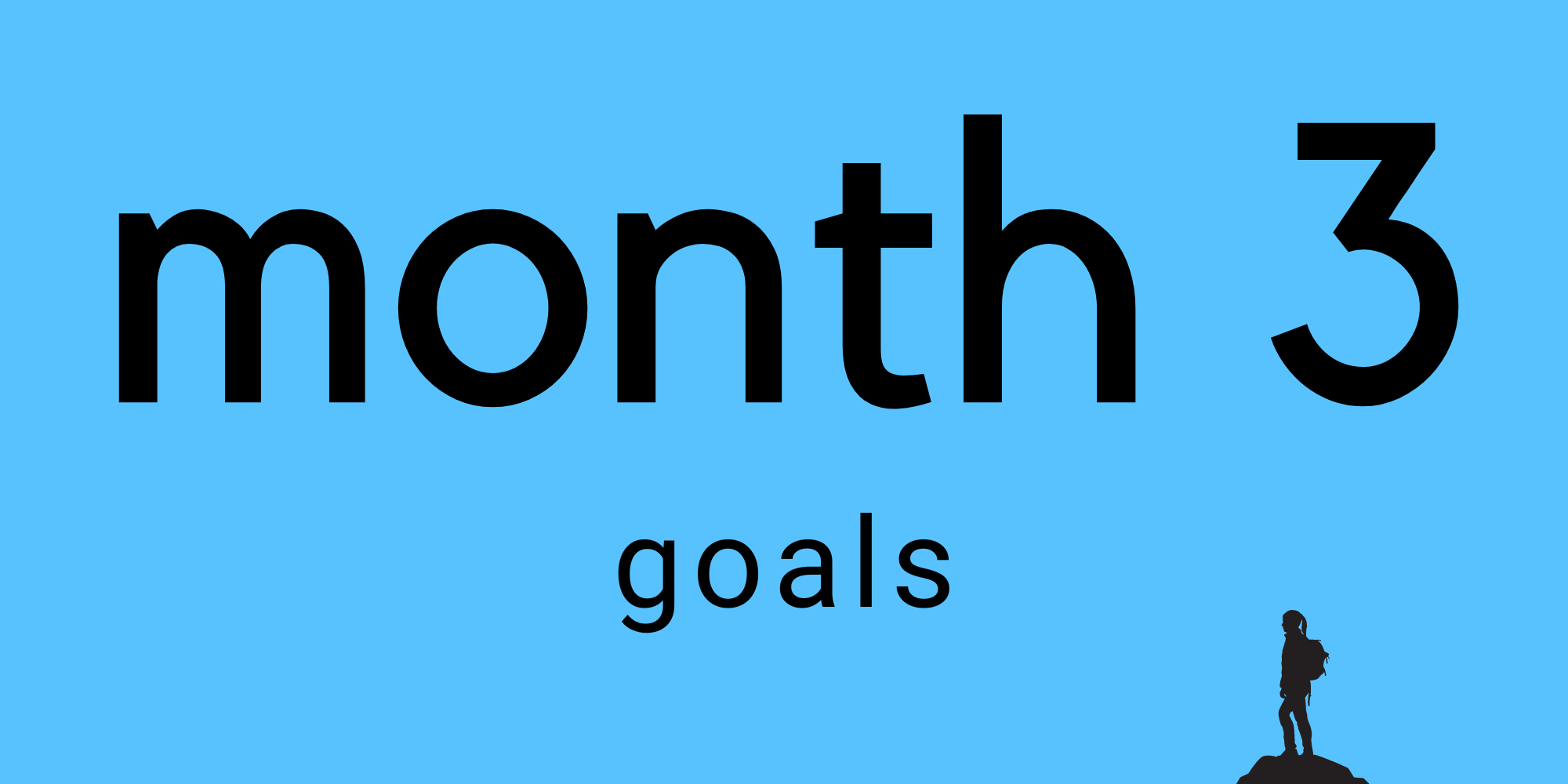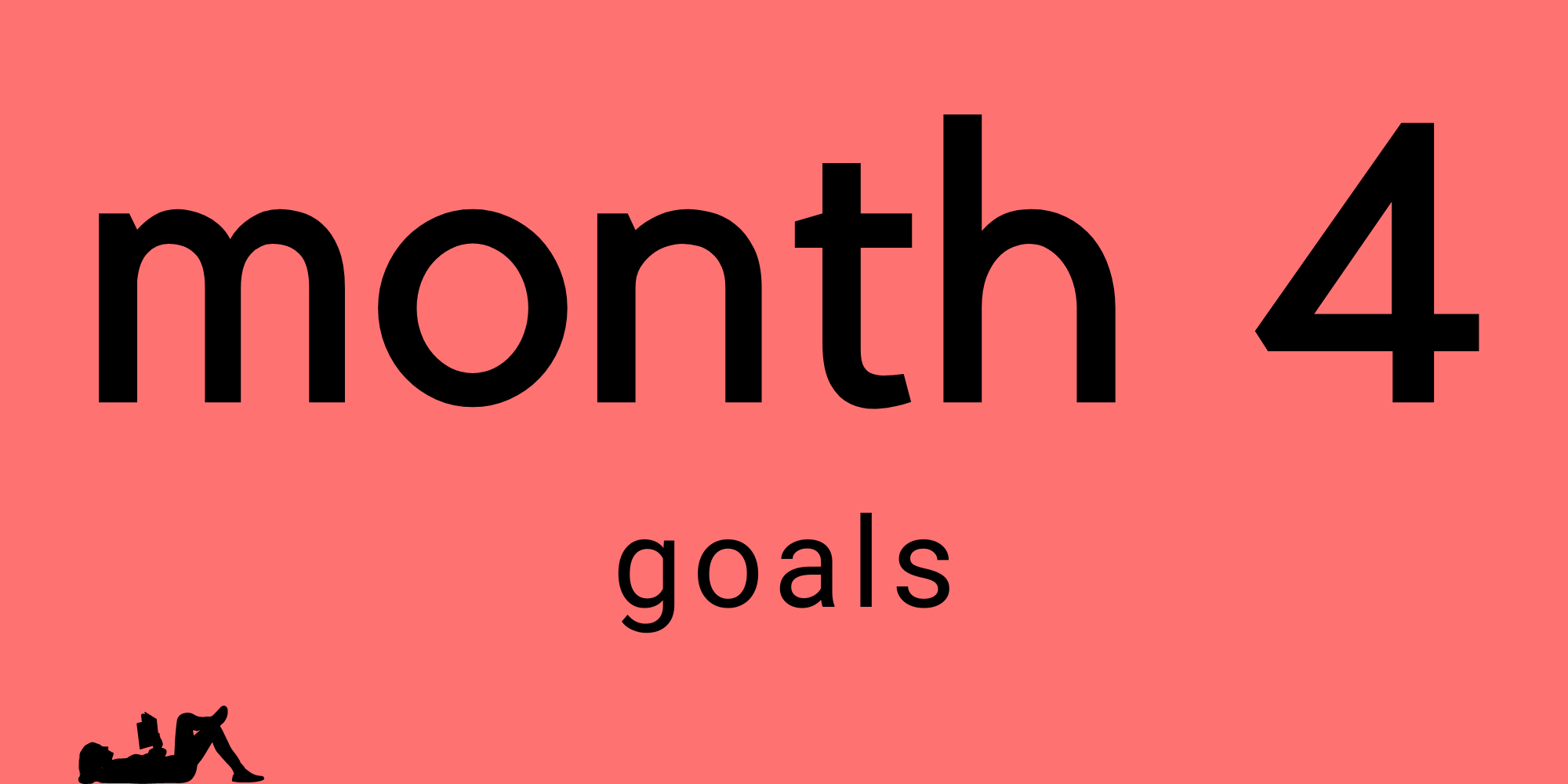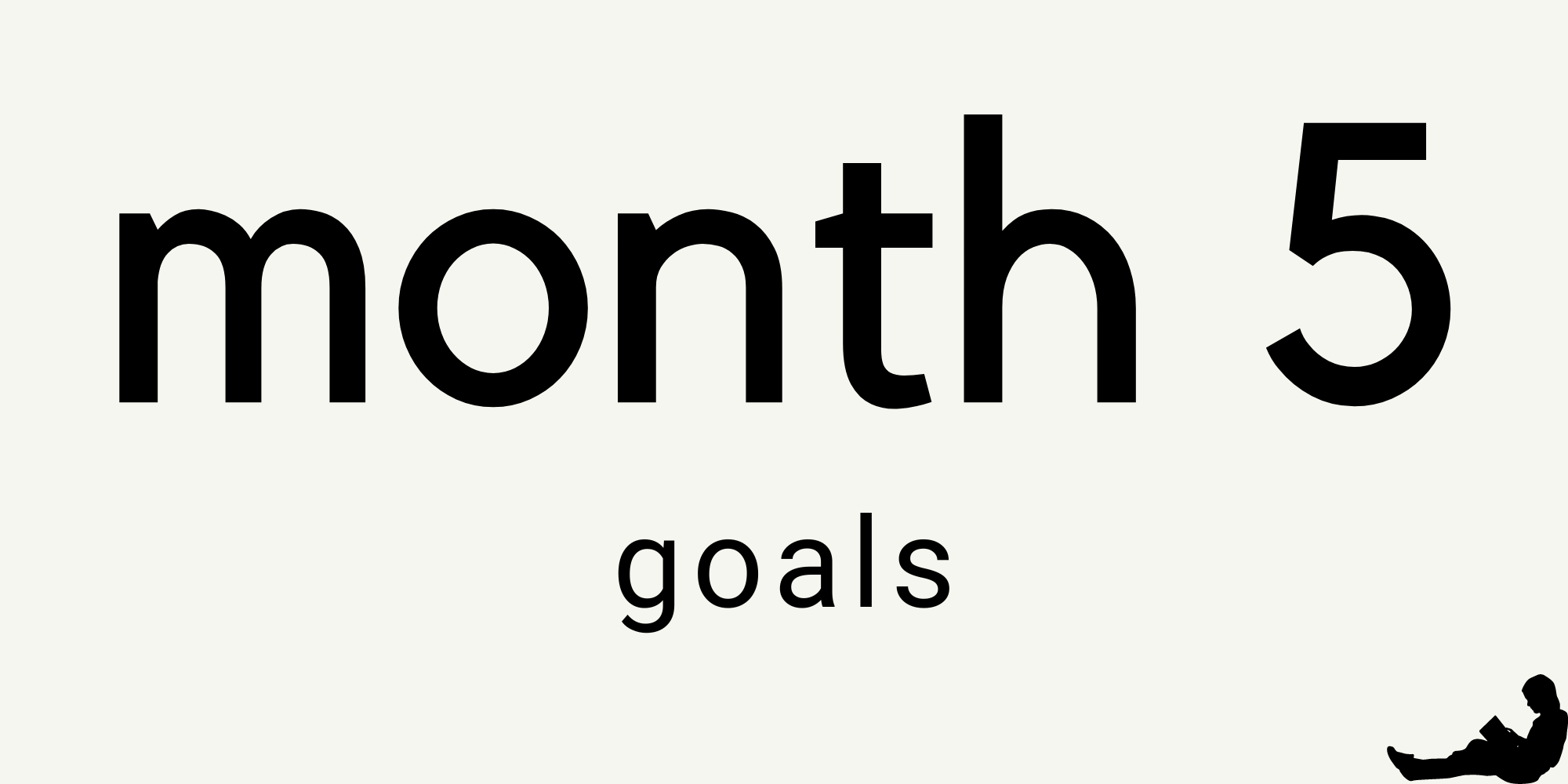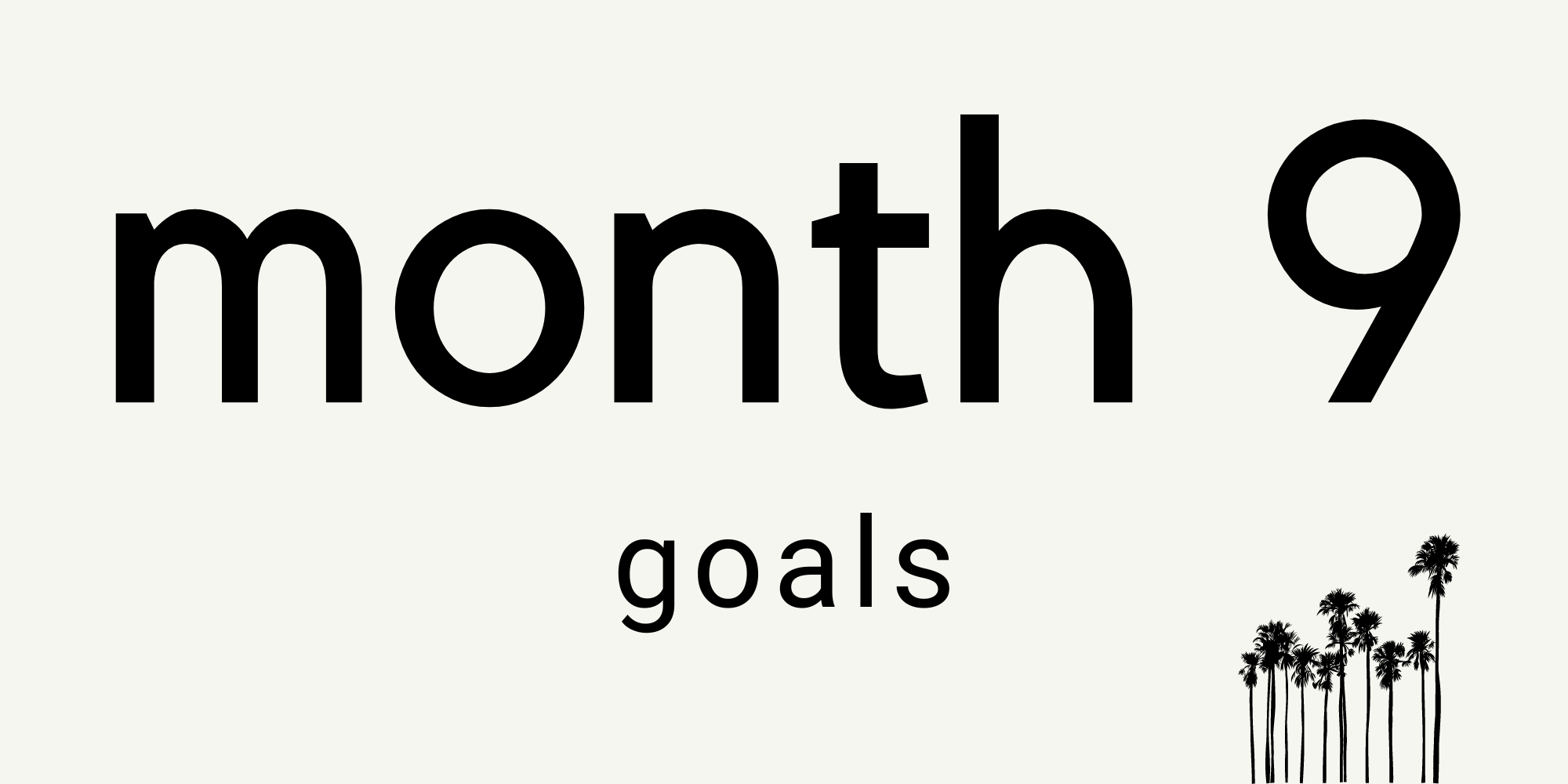50 Blog Goals In 1 Year (an epic monthly breakdown)
Setting goals is smart. But what’s even smarter is setting checkpoints. So welcome to my list of epic blog goals, broken down into monthly targets.
These checkpoints build upon each, so this list mimics a real world, sustainable blog growth strategy.
The goals come from my many years of blogging and reflect what I’ve found to be the most important things to focus on (and when to focus on them).
Because prioritizing the right things at the right time matters.
But enough chit chat – let’s get it.
Table of Contents Show
Hey there, just a heads up that some of the links in this post may be affiliate links. That means I earn a small commission. This is at no extra cost to you, but helps me keep the lights on. Thank you for your support!
Month 1 Blog Goals
Month 1 is a collection of blog goals for beginners.
These are the things I would focus on first if I was starting out.
1. Become One With Your Niche
Whether you’re already an expert or on your way to becoming one, knowing your niche is essential.
Understanding your reader is how you will create compelling, original content.
Google also prioritizes hands-on experience in deciding the quality and authoritativeness of an article and website.
What this means is your niche participation and experience matters (good news if you’re worried about AI-generated content).
So, become one with your niche.
2. Learn SEO (the basics)
SEO (search engine optimization) is how your posts rank in places like Google.
This will be your primary source of traffic, so learning the basics is essential (luckily it’s not too difficult).
I won’t dive into all the nuts and bolts here, but you can check out how I do SEO in this article.
3. Build Out Your Site
This is one of my favorite parts about blogging – website tinkering.
It’s creative and it’s fun.
Building out your site means:
Choosing a blog platform
Connecting your site to Google Search Console
Adding relevant pages (contact and about pages, a privacy policy, etc.)
Choosing a theme and a design aesthetic (your branding)
Recommended Read: The Key Characteristics of A Great Blog
4. Curate A List of 100 Target Keywords
Keywords are the backbone to your site. And it all starts with good keyword research (which is an ongoing thing).
I keep all of my keywords in a Google Doc for organization and I categorize everything by audience subsets and topic clusters.
You can read how I do keyword research here.
5. Publish Your First Post(s)
Once you have your site all set up and a collection of keywords ready to go, it’s time to write.
Writing is something you’ll be doing for as long as your blog is active. Although, as you grow and start making money, outsourcing this part is also an option.
But for now, just focus on writing and pushing out your first posts.
Recommended Read: How Many Posts to Launch A New Blog With
Month 2 Blog Goals
Month 2 goals support habit formation and set you up for success.
These ideas are key for your blog’s growth.
6. Create A Blogging Workflow
A blog workflow is a repeatable system you can follow.
It’s a set of processes and steps for researching, writing and publishing your posts.
It keeps you accountable, supports habit formation and boosts your productivity.
You can read more about my personal blogging workflow here.
7. Define Your Posting Schedule
Having a posting schedule that fits your lifestyle and blog goals is important.
Because (as with anything) consistency is key. Creating a content calendar helps you stay accountable and supports good blogging habits
So what’s a realistic blog post schedule you can stick to?
I would recommend starting with a minimum posting frequency (at least 1 post a week ideally).
Some weeks you may post more, but you’ll always publish at least one.
8. Isolate Your Strengths + Weaknesses
As you start writing more and building out your blog, you’ll realize that you’re good at some things – but bad at others.
This is normal.
Recognizing your weaknesses and bottlenecks (such as time management or distractions) means you can create solutions and workarounds for them.
And knowing your strengths means you can lean into them so you can get more done.
Month 3 Blog Goals
Month 3 goals help you solidify your brand image and your blog’s foundation.
These ideas represent a key milestone in your blogging path.
9. Fine-Tune Your Brand + UVP
Chances are, your brand image and differentiation won’t be 100% clear when you first start.
But by your third month of blogging, you’ll likely have a better picture of who you are and how you fit into your niche.
So now we can do a quick audit of how things are going.
Does your current image and writing reflect your long-term goals and who you want to be?
Clearly define your brand voice and UVP (your unique value proposition) and create guidelines you can follow moving forward.
A UVP can be a unique angle or perspective. For example, I use my experience as a musician, artist and traveler in many of my blogs.
10. Submit Your Sitemap to Google Search Console
In month 1 goals, I mentioned connecting your website to Google Search Console.
Every blogging platform will have a slightly different protocol here, but if you haven’t done that yet, here’s a general overview.
(you can also do a quick Google search of “your blog platform” + “google search console”)
But once you’re connected, it’s time to submit your site map.
A site map is a way for Google to better crawl and understand your blog and all of its pages. This offers a lot of benefits.
Luckily, it’s pretty simple to submit one. Here’s an article from Semrush that outlines the process.
11. Hone In On Your Blogger’s Mindset
By month 3, there’s a good chance that the honeymoon phase of blogging will be coming to an end.
Exciting results probably aren’t happening yet and your motivation to continue at the same speed may feel weaker.
So we need a different source of motivation. We need a blogger’s mindset.
For me, this means addressing any unresolved fixed mindset beliefs, thinking in the long-term and using realistic time horizons.
12. Publish 30 Blog Posts
By the end of month 3, a solid goal is to reach 30 published posts.
This can seem like a lot, but it’s important to stay diligent in these earlier stages of starting a blog.
This is when your motivation is highest and the quickest way to get better (and see results) is to put in the work.
Luckily, there are AI tools to help streamline things – but don’t rely on AI to write everything for you. Remember, Google prioritizes hands-on experience in its ranking.
And AI-written blogs tend to be pretty generic and boring (so far, at least…).
So keep AI for fleshing out ideas, outlining, finishing thoughts and brainstorming new ideas – but remember to add your personal touch.
Month 4 Blog Goals
Month 4 is focused on promotion efforts and unlocking some initial opportunities.
These goals will improve your confidence and boost awareness for your site.
13. Get Some Outside Feedback
Getting outside feedback for your blog gives you objectivity and fresh insights.
For example, when I ask friends for feedback, I’m always surprised to learn which of my topics are resonating more than others.
This helps me to know which areas I should explore more.
It’s worth noting though that you should seek feedback from someone who’s actually in your target audience.
And also pay attention to your intuition to know which advice you should listen to and which you shouldn’t.
(not every opinion is helpful)
14. Find Guest Posting Opportunities
Guest posting opens up a lot of opportunities as a blogger.
It helps you reach new audiences, network with other leaders in your space and build inbound links pointing to your site (which improves your site ranking and authority).
You can learn more about how to find guest posting opportunities here.
15. Engage More With Your Niche
Engaging more with your niche means joining relevant communities, posting helpful threads and hopping into the comments.
Joining in the conversation is a great way to build authority while promoting your blog (if done right).
You can engage with your niche more on social media, community forums (like Reddit or Quora) and Facebook groups.
(you can also get great blog topic ideas here)
16. Pull A Few Monetization Levers
At month 4, I wouldn’t expect any large amounts of money yet, but it can be encouraging (and smart) to get a few balls rolling.
For example, you can:
Apply to a few affiliate programs
Amazon Associates Program is a common option, but there are tons more
Offer services
Add a “Hire Me” button in your main menu or in your sidebar if you have expertise related to your niche and content
Start putting ads on your blog
Google AdSense and Ezoic are popular ad networks for newer blogs
Month 5 Blog Goals
Month 5 goals focus on building out your infrastructure and exploring alternative traffic channels.
These goals will help increase your traffic, authority and clarity.
17. Improve Your Blog’s Accessibility
Blog accessibility is important. It ensures that your site is readable and easy to navigate for people with disabilities.
So now is a good time to make sure you’re not missing any key things.
Here’s a helpful post from HubSpot with tips and strategies to follow.
18. Implement A Social Media Strategy
People don’t just use Google to search for solutions or find answers to questions.
More and more people are wanting (and expecting) different content types (beyond a blog post).
For example, younger generations are more likely to use places like TikTok and Instagram over traditional search engines like Google.
So it’s a smart goal to implement a social media strategy for your blog.
This could mean turning your posts into Instagram carousels, summarizing your blogs into tweets or transforming your posts into short-form videos for TikTok and YouTube.
Recommended: Vlog vs. Blog vs. Social Media (+ how to choose)
19. Try Out Pinterest for More Traffic
Pinterest is a whole different beast. It stands on its own and many bloggers use it to drive massive amounts of traffic to their site.
If you follow the right strategy, it can be much quicker than getting traction in Google.
Here’s a post from Create And Go on how to use Pinterest to grow your blog.
20. Explore Content Syndication Opportunities
This is another (less talked about) way to increase exposure to your blog.
Content syndication is when you republish your content on another website, often with a larger following and more authority.
There’s a right and wrong way to do this (because Google doesn’t like duplicate content), so be sure to follow the right strategy.
Here’s a post from HubSpot to learn more.
Month 6 Blog Goals
Month 6 is when things really start to heat up. You’ll be hitting important growth milestones.
These goals will improve your skills and set you up for the next 6 months.
21. Invest In Your Blog (skill building)
The blogging journey is never-ending. We’ll forever be learning, adapting and getting better.
So now is a great time to think about what skills you could improve upon or how you could level up.
Blogging requires you to wear a lot of hats. So skill building is a smart investment, which can be time-based (like free YouTube videos), money-based (like a course) or both.
Here are some next-level blogging skills worth exploring:
AI integration
Blogging automation
Copywriting and writing skills
Learning how to build out a digital course
Data analytics (more on this in month 8)
Advanced SEO tactics (more on this just below)
Sales tactics and digital marketing
22. Implement More Advanced SEO Tactics
I prefer a minimalist SEO strategy overall, because it’s been working great for me so far.
Still, there are some advanced moves worth learning and trying out.
For example
Building out more inbound links (backlinks)
Optimizing for voice search
Researching how AI and natural language models will affect things
Reverse outreach (a Backlinko strategy)
23. Start Making An eBook or A Freebie
By month 6, you’ve likely gathered a good amount of expertise, data and knowledge for what’s working and what your audience wants.
So now can be a great time to start creating your first ebook or some type of digital download you can offer for free.
This can become a key asset as you grow. And if not, it’s a great learning experience.
My first ebook didn’t do well at all…but it taught me a lot.
24. Publish 50 Blog Posts
By month 6, a great goal to aim for is to publish 50 posts.
This is about the time I hit this milestone and it’s a great checkpoint to strive for.
Month 7 Blog Goals
Month 7 will focus on creating more assets and taking care of some important housekeeping.
These goals will improve the quality and scope of your posts and your brand while opening up exciting new doors.
25. Start A Newsletter
Remember that freebie (or ebook) from above? We can put that to work here.
Growing an email list is like the holy grail for many bloggers and entrepreneurs. It’s one the best ways to reach your audience and it’s an audience you “own”.
You have their email and a direct and personalized way to communicate with them.
There are no algorithms, trends or disruptions that can take this away from you. Some people recommend starting a newsletter right from the start.
But I like to wait, since I don’t understand my audience fully in the beginning. But the more I write and rank, the better I understand what performs well and what people like and engage with most.
So for me, a great goal for month 7 is to start building out an email list. You can learn more here.
26. Turn Your Blogs Into Videos
Turning your blogs into video or short form content is a smart move.
You could even start a whole YouTube channel for your blog.
Video content is a great way to increase your exposure and boost your site’s quality. Plus, it’s a valuable and in-demand creative skill to know.
It’s worth noting that you could implement this goal way earlier. After all, video is all the rage.
27. Review + Update Your First Batch of Articles
Chances are, your first round of blogs will need some love.
Not every post will need a full reno, but you’ll probably want to update information or revamp things (since you’ve likely gotten much better at blogging).
Plus, you can update the dates on older articles to keep things looking current. This improves the likelihood that people will click on your post over other (older) ones.
28. Hit 5,000 Monthly Visitors
An awesome goal to work toward by the end of month 7 is to hit 5,000 monthly visitors to your blog.
If you’ve been consistent and implemented good keyword research and SEO tactics, this is more than achievable (you may even surpass the goal).
But of course, don’t stress if you’re not here yet.
Remember, blogging is a long-term game.
Month 8 Blog Goals
Month 8 is all about advanced optimization and becoming a data and productivity wizard.
These goals will enhance your blog’s performance and efficiency.
29. Learn the Data – Read the Data
Data analytics has always been one of my weaknesses as a blogger.
But I know it’s critical.
So by month 8, you’ll likely have some decent data to sift through. For example, which of your blogs are performing best and why?
What’s your bounce rate and your average monthly CTR (clickthrough rate)?
How about your newsletter’s open rate?
These blogging metrics (and more) are all important benchmarks to know. They are your KPIs, your key performance indicators.
Understanding this data can guide your decision making and improve your blog's performance and optimization efforts. You can learn more about blog data here.
30. Learn GA4
GA4 is a great place to find data on your blog (besides data from your website’s back office, plugins or Google Search Console).
GA4, or Google Analytics 4, is a one-stop shop for metrics and insights about your readers and how your blog performs.
Here’s a guide from Search Engine Journal to learn more about it.
31. Gather Original Data
Original data is awesome. It’s hard to compete with and helps you stand out.
Some great ways to gather your own data include:
Conduct a survey or poll
Do A/B split testing (for headlines, outlines, strategies helpful for your audience)
Do a case study
Interview a leader in your space
Once you do have the data, you can put your findings into a long-form white paper for your audience and optimize it for a high-value keyword.
This can drive a lot of valuable traffic and increase your inbound links (since data-based posts tend to do well and are often linked to by other sites).
32. Try Out Some Pro Blogging Tools
You’re probably already familiar with tools like Google Search Console and maybe some keyword research platforms.
But there’s so much more out there.
Of course, you don’t need any fancy tools – especially if you’re a beginner – but there is a time and place for some of them.
Month 8 is that time and place (although, you may use some of these way earlier).
A few of my go-to tools for blogging include:
Notion (for organization)
Frase (for content optimization)
Grammarly or other AI (for editing)
Ahrefs (for keyword research)
Month 9 Blog Goals
Month 9 is money-focused (woo!).
These goals will help you increase your blog’s income potential.
33. Create A Digital Product
Digital products are all the rage – but for good reason.
They’re a form of passive income.
A digital product is something you create once and it continues to sell itself without you needing to recreate it (although updates, promo work and maintenance help).
So month 9 is a great time to focus on this goal.
You can learn more about creating digital products as a blogger here.
34. Start A Store
Having a store on your site is a great way to sell personal branded products.
These items could be print on demand, custom products or digital stuff (such as art prints, ebooks and templates).
Just make sure the store products align with your niche and brand. You can also focus on learning ecommerce SEO, so you can drive organic traffic to your products.
35. Join A Better Ad Network
I mentioned joining Google AdSense above (goal #16). But there are better ad networks that pay you more.
Although, these better networks usually require blogs to have more traffic.
So if you’ve stayed diligent over the past 9 months, there’s a good chance your numbers are higher, so you can start exploring some of these options.
A few popular ad networks that pay you more than Google include:
Ezoic (no minimum traffic)
Mediavine (minimum traffic: 50,000 visitors/month)
AdThrive (minimum traffic: 100,000 visitors/month)
36. Work Towards More Consistent Income
There are numerous ways to monetize a blog.
So by the end of month 9, many bloggers become more serious about monetization (I did, at least).
Working towards more consistent income means pulling the right levers, knowing how, where and when to sell and staying patient.
Consistent income is the result of traffic, good sales copywriting, relevant product choices and understanding keywords within a sales funnel.
Here are some other monetization channels (besides affiliate marketing, ads and products):
Paid membership
Sponsored posts
Selling ad space directly
Starting a Patreon or adding a donations button
Month 10 Blog Goals
Month 10 will focus on adding advanced features and more functionality to better wow your audience.
These goals will improve your blog’s professionalism, quality and trust.
37. Do A UX Overhaul (advanced moves)
UX stands for user experience – and it’s super important.
Good UX means your readers can easily navigate your site, are able to find the content they need and just have a good time while stopping by.
You’re likely already doing some good UX (such as avoiding large blocks of text, having search functionality, etc.). But there are some more advanced moves worth exploring.
For example, you could:
Improve engagement and interaction with gamification, quizzes and calculators
Make your content more interactive with dynamic features or fly-in animations
Mobile optimization (although this should be a priority from the start)
Adding a chatbot (more on this just below)
38. Boost Conversions + Retention
Good UX will boost your retention and conversions. But there’s more we can do to optimize things.
Here are some advanced ways to increase your retention and boost conversions:
Use emotion to draw the reader in
Add amazing value and write clearly to keep reader’s attention
Use social proofing (like showing recent activity popups or the number of social shares a post has)
Add web push notifications so readers can opt in to get notified when you have new posts
Create an irresistible offer and add CTAs strategically in relevant places
Add an email popup when readers go to exit your site
38. Involve the Reader
Involving the reader is a great goal for making your blog stand out.
Here are a couple ways to involve your readers more:
Feature user-generated content (invite them to share their stories and experiences)
Run a contest or giveaway
Live streams, Q&As or AMAs
Collaborations
Create a private membership community for discussions and networking
40. Integrate An AI Chatbot
AI is here to stay. So I’m focusing part of my time on learning it and using it.
As bloggers, AI doesn’t end with content generation, editing or brainstorming. One particular tool (which I’m keen to try next) is an AI chatbot.
You can now upload websites or documents (for example, all of your blog posts) and turn that information into a personalized chatbot that’s trained in your content.
So visitors (rather than searching and sifting through posts) can use an AI chatbot to ask questions and find answers related to your niche and expertise.
Pretty cool.
A couple options for this integration are Dante, UseChat and HelpHub by CommandBar.
Month 11 Blog Goals
Month 11 is focused on finding and plugging any leaking holes in your blog and the assets you’ve built out so far.
These goals should address technical issues and further optimize your site.
41. Review Underperforming Blogs
Not all of your blogs will perform well or rank.
So regularly analyzing your keywords and ranking pages is important.
By month 11, you’ll probably have a collection of posts that aren’t ranking or performing well.
Some posts may not even be indexed into Google yet – even if you requested immediate indexing from within your Google Search Console.
So this goal focuses on finding those underperforming posts and either rewriting them or reoptimizing them (with different keywords, better structuring or new information).
42. Audit Your Site for Broken Pages + Bunk Links
Another problem area to check for (as your blog grows) is broken links and/or pages.
I never have broken links on my own site (because once I publish a post, I never change the URL or delete it).
But sometimes, other websites take down posts or change URLs on you (without doing a 301 redirect).
This can be upsetting for readers and ruins your blog’s performance and SEO.
So here’s an article that walks you through how to find these types of problems and fix them.
43. Optimize Your Time
Time is our greatest asset.
It’s actually the whole reason I started a blog in the first place (to create an automated business and free up time for future me).
So now’s a good time to start exploring ways to optimize it. Here’s how I boost my time efficiency as a blogger:
Figure out which tasks have the biggest impact (and which have the smallest)
Automate, delegate or delete the smaller-impact actions
44. Optimize Your Newsletter
If you’ve been focusing on growing your newsletter, chances are it could use some love.
For example, you could explore ways to improve open rates or how to create better, more compelling content.
You can look at the data inside your email automation software or you can ask your readers directly for feedback and requests.
Month 12 Blog Goals
By month 12, your blog is really starting to look like a fully-fledged business.
You’ve hit key milestones and developed a personal brand for yourself. These next goals reflect those achievements.
45. Publish 100+ Blog Posts
By the end of year 1, a great goal is to have published 100 blog posts.
This is an awesome milestone and this is when things really start to get exciting and grow.
But if you’re not there yet, just keep at it (remember, blogging is a long-game).
46. Reach 10,000+ Monthly Visitors
Another great goal after 1 year of blogging is to hit the 10,000 monthly visitors mark.
You may be under – or you may be way over.
Either way, it’s a great target to strive for.
47. Go To A Blogging Conference
Nothing says I mean business like attending an industry conference.
This is an exciting first year goal to look forward to – even if you haven’t hit all of the milestones you were hoping for.
Conferences are awesome places to learn trending skills, network and promote your brand.
A quick Google search of “blogging conferences” should point you in the right direction.
48. Review Your Past Year + Plan Out the Next
Self reflection (while looking ahead and mapping out your next moves) is fun – and smart.
It’s a strategic way to remind yourself of what worked and what didn’t. This can guide you as you move into your second year.
You can plan out your next batches of content, spend time researching new sub-niches and set goals for the next year (hm, I may need to make another post…).
2 Bonus Blogging Goals (looking ahead)
These last blogging goals are things I would focus on after meeting the majority of the goals above.
They may take some time, but they’re super exciting moments.
49. Become An Authority In Your Niche
Becoming an authority takes time. But rest assured, you can do it.
Sometimes, the thing that separates the niche leaders from everyone else is the leaders just never gave up and had a relentless hunger to keep moving forward.
Still, you don’t need to be the MVP or some top performer to be successful.
The tailend of success is long. And there’s always room for more than one leader.
50. Go Full-Time
Going full-time is the ultimate goal as a blogger.
This can absolutely happen in your first year – but it may take a few more.
It all depends on things like your niche competition, your posting consistency, the quality of your content and your keyword research.
But it’s definitely possible…nay, it’s inevitable if you stick with it.
Want More? Check Out These Sweet Reads!

















